345. The only other similar glyph in the text came 70 right ascension days later:
| CHRISTMAS EVE (358) |
69 |
MARCH 4 (*348 = *278 + 70) |
400 |
| ST JOHN'S DAY (175 = 358 - 183) |
SEPT 2 (*165 = 175 - 80 + 70) |
 |
 |
| Gb2-23 (278 = 358 - 80) |
Gb4-28 (348 = 428 - 80 = 12 * 29) |
| 71 = 471 - 400 (= 26000 / 365.25) |
| SEPT 2 (245) + 10 * 29½ = 540 (= 360 * 1½ = 2 * 270) = 365 + 175 (ST JOHN'S DAY) |
... The evening of 23 June, St. John's Eve, is the eve of celebration before the Feast Day of Saint John the Baptist. The Gospel of Luke (Luke 1:36, 56-57) states that John was born about six months before Jesus; therefore, the feast of John the Baptist was fixed on 24 June, six months before Christmas Eve ...
The significant star at Gb2-23 was Situla (κ Aquarii, the Water-jar) and this fits well with the character of St John the Baptist:
| Egyptian sticks |
 |
Phoenician taw |
 |
Greek chi |
Χ (χ) |
| Greek tau |
Τ (τ) |
|
In Plato's Timaeus, it is explained that the two bands that form the soul of the world cross each other like the letter Χ.

Roman XII = 12 → XIII = 13, with the Nose in between - and later, after the Mouth, the cycle would begin anew (I).
Chi or X is often used to abbreviate the name Christ, as in the holiday Christmas (Xmas). When fused within a single typespace with the Greek letter Rho, it is called the labarum and used to represent the person of Jesus Christ. (Wikipedia)

... tau is the 19th letter of the Greek alphabet. In the system of Greek numerals it has a value of 300 ... Taw is believed to be derived from the Egyptian hieroglyph meaning 'mark' ...
Taw, Tav or Taf is the twenty-second and last letter in many Semitic abjads ... In gematria Tav represents the number 400, the largest single number that can be represented without using the Sophit forms ...
'From Aleph to Taf' describes something from beginning to end; the Hebrew equivalent of the English 'From A to Z' ...
Tav is the last letter of the Hebrew word emet, which means truth. The midrash explains that emet is made up of the first, middle, and last letters of the Hebrew alphabet (Aleph, Mem, and Tav...). Sheqer (falsehood), on the other hand, is made up of the 19th, 20th, and 21st (and penultimate) letters.
Thus, truth is all-encompassing, while falsehood is narrow and deceiving. In Jewish mythology it was the word emet that was carved into the head of the Golem which ultimately gave it life. But when the letter 'aleph' was erased from the Golem's forehead, what was left was 'met' - dead. And so the Golem died ... (Wikipedia)

|
... Night came, midnight came, and Tuu Maheke said to his brother, the last-born: 'You go and sleep. It is up to me to watch over the father.' (He said) the same to the second, the third, and the last. When all had left, when all the brothers were asleep, Tuu Maheke came and cut off the head of Hotu A Matua. Then he covered everything with soil. He hid (the head), took it, and went up. When he was inland, he put (the head) down at Te Avaava Maea. Another day dawned, and the men saw a dense swarm of flies pour forth and spread out like a whirlwind (ure tiatia moana) until it disappeared into the sky. Tuu Maheke understood. He went up and took the head, which was already stinking in the hole in which it had been hidden. He took it and washed it with fresh water. When it was clean, he took it and hid it anew. Another day came, and again Tuu Maheke came and saw that it was completely dried out (pakapaka). He took it, went away, and washed it with fresh water until (the head) was completely clean. Then he took it and painted it yellow (he pua hai pua renga) and wound a strip of barkcloth (nua) around it. He took it and hid it in the hole of a stone that was exactly the size of the head. He put it there, closed up the stone (from the outside), and left it there. There it stayed.
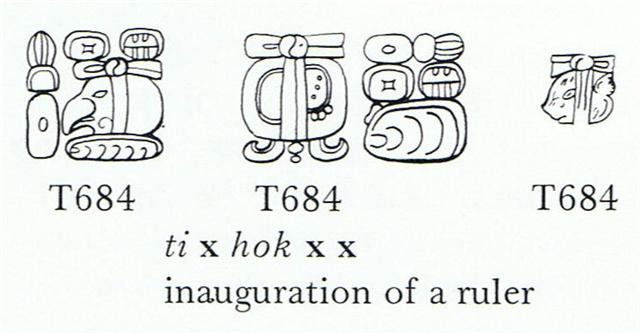
Another year passed, and a man by the name of Ure Honu went to work in his banana plantation. He went and came to the last part, to the 'head' (i.e., the upper part of the banana plantation), to the end of the banana plantation. The sun was standing just right for Ure Honu to clean out the weeds from the banana plantation. On the first day he hoed the weeds. That went on all day, and then evening came. Suddenly a rat came from the middle of the banana plantation. Ure Honu saw it and ran after it. But it disappeared and he could not catch it. On the second day of hoeing, the same thing happened with the rat. It ran away, and he could not catch it. On the third day, he reached the 'head' of the bananas and finished the work in the plantation. Again the rat ran away, and Ure Honu followed it. It ran and slipped into the hole of a stone. He poked after it, lifted up the stone, and saw that the skull was (in the hole) of the stone. (The rat was) a spirit of the skull (he kuhane o te puoko). Ure Honu was amazed and said, 'How beautiful you are! In the head of the new bananas is a skull, painted with yellow root and with a strip of barkcloth around it.' Ure Honu stayed for a while, (then) he went away and covered the roof of his house in Vai Matā. It was a new house. He took the very large skull, which he had found at the head of the banana plantation, and hung it up in the new house. He tied it up in the framework of the roof (hahanga) and left it hanging there ...
Counted from η Carinae - which evidently was the last Greek lettered star in the hull of Argo Navis - the Water-jar (for inaugurating the new ruler) came after 180 days, but I have arranged my nakshatra stars 183 days after their true heliacal positions - instead of arranging the heliacal stars 180 days after their positions close to the Full Moon.
The idea of 'baptism' (Greek: báptein = dip) was probably inherited from the ancient Babylonians and their fish-god Oannes (Iōannēs, Giovanni, Juan, Ivan, Iain, Jean, Hans, John, etc).
... The Mahabharata insists on six as the number of the Pleiades as well as of the mothers of Skanda and gives a very broad and wild description of the birth and the installation of Kartikeya 'by the assembled gods ... as their generalissimo', which is shattering, somehow, driving home how little one understands as yet. The least which can be said, assuredly: Mars was 'installed' during a more or less close conjunction of all planets; in Mbh. 9.45 (p. 133) it is stressed that the powerful gods assembled 'all poured water upon Skanda, even as the gods had poured water on the head of Varuna, the lord of waters, for investing him with dominion'. And this 'investiture' took place at the beginning of the Krita Yuga, the Golden Age ...

... in the ceremonial course of the coming year, the king is symbolically transposed toward the Lono pole of Hawaiian divinity ... It need only be noticed that the renewal of kingship at the climax of the Makahiki coincides with the rebirth of nature. For in the ideal ritual calendar, the kali'i battle follows the autumnal appearance of the Pleiades, by thirty-three days - thus precisely, in the late eighteenth century, 21 December, the winter solstice. The king returns to power with the sun. Whereas, over the next two days, Lono plays the part of the sacrifice. The Makahiki effigy is dismantled and hidden away in a rite watched over by the king's 'living god', Kahoali'i or 'The-Companion-of-the-King', the one who is also known as 'Death-is-Near' (Koke-na-make). Close kinsman of the king as his ceremonial double, Kahoali'i swallows the eye of the victim in ceremonies of human sacrifice ... In the deep night before the image [of Lono] is first seen, there is a Makahiki ceremony called 'splashing-water' (hi'uwai). Kepelino tells of sacred chiefs being carried to the water where the people in their finery are bathing; in the excitement created by the beauty of their attire, 'one person was attracted to another, and the result', says this convert to Catholicism, 'was by no means good'.
At dawn, when the people emerged from their amorous sport, there standing on the beach was the image of Lono. White tapa cloth and skins of the ka'upu bird hang from the horizontal bar of the tall crosspiece image. The ka'upu is almost certainly the albatross, a migratory bird that appears in the western Hawaiian chain - the white Lanyon albatross at Ni'ihau Island - to breed and lay eggs in October-November, or the beginning of the Makahiki season ...

| CLOSE TO THE SUN: |
| 12-7 (*261 = 9 * 29) |
12-8 |
12-9 (343 = 7 * 7 * 7) |
12-10 |
12-11 |
12-12 |
 |
94 |
 |
48 |
 |
64 |
 |
236 |
25 |
| Ga1-26 |
Ga5-11 (121) |
Ga7-1 (170) |
Gb1-6 (235) |
| 96 |
49 |
65 |
261 |
| 145 = 5 * 29 |
5 * 13 |
9 * 29 |
| 471 = 210 + 261 = 5 * 42 + 9 * 29 |
|
| DEC 22 |
23 (*277) |
CHRISTMAS EVE |
25 |
26 (360) |
27 |
 |
 |
 |
 |
 |
 |
| Gb2-21 |
Gb2-22 |
Gb2-23 |
Gb2-24 (50) |
Gb2-25 (280) |
Gb2-26 |
| δ Tucanae (340.1), ρ Cephei (340.2), ν Gruis (340.3), ζ Aquarii, δ Gruis (340.4), 5/1100 Lac. (340.7), σ Aquarii, 6/650 Lac. (340.9)
PROCYON (α Canis Minoris)
|
υ Oct. (341.0), α/91 Lac. (341.1), HOMAN (Hero) = ζ Pegasi, β Piscis Austrini (341.2), ν Tucanae (341.5), υ Aquarii (341.9) |
η Aquarii (342.1), σ Gruis (340.4), SITULA (Water-jar) = κ Aquarii (342.7) |
ε Piscis Austrini (343.5), ο Pegasi, β Gruis (343.8) |
ρ Gruis (344.0), MATAR (Rain) = η Pegasi (344.2), η Gruis (344.6), β Oct. (344.7) |
λ Pegasi (345.0), ξ Pegasi (345.1), ε Gruis (345.3), τ Aquarii (345.7), ξ Oct. (345.8), μ Pegasi (345.9) |
| Febr 24 |
25 |
26 (57 = 3 * 19) |
27 (*343) |
28 (424) |
March 1 (*345) |
| °Febr 20 |
21 (54) |
22 (420) |
Terminalia |
24 (*340) |
25 |
| 'Jan 28 (393) |
29 (*314) |
30 |
31 |
'Febr 1 |
2 (33) |
| "Jan 14 |
15 (*300) |
16 |
Tua Haro 17 |
18 (383) |
19 |
| CLOSE TO THE FULL MOON: |
| 6-7 |
6-8 |
6-9 (*80) |
6-10 (161) |
6-11 |
6-12 (*84 - *1) |
| JUNE 22 |
23 |
ST JOHN'S DAY |
25 (*96) |
26 (177) |
27 |
| Extended Net-26b
μ Hydrae (157.1) |
Maru-sha-arkat-Sharru-15 (4th Son behind the King) SHIR = ρ (rho) Leonis (158.9) |
p Carinae (159.3) |
φ Hydrae (160.3) |
no star listed (161) |
VATHORZ POSTERIOR = θ Carinae (162.1), PEREGRINI = μ Velorum, η CARINAE (162.6) |
|
"This [η Carinae] is one of the most noted objects in the heavens, perhaps even so in almost prehistoric times, for Babylonian inscriptions seem to refer to a star noticeable from occasional faintness in its light, that Jensen thinks was η. And he claims it as one of the temple stars associated with Ea, or Ia, of Eridhu¹, the Lord of Waters, otherwise known as Oannes², the mysterious human fish and greatest god of the kingdom.
¹ Eridhu, or Eri-duga, the Holy City, Nunki, or Nunpe, one of the oldest cities in the world, even in ancient Babylonia, was that kingdom's flourishing port on the Persian Gulf, but, by the encroachment of the delta, its site is now one hundred miles inland. In its vicinity the Babylonians located their sacred Tree of Life.
² Berōssōs described Oannes as the teacher of early man in all knowledge; and in mythology he was even the creator of man and the father of Tammuz and Ishtar, themselves associated with other stars and sky figures. Jensen thinks Oannes connected with the stars of Capricorn; Lockyer finds his counterpart in the god Chnemu of Southern Egypt; and some have regarded him as the prototype of Noah." (Allen)
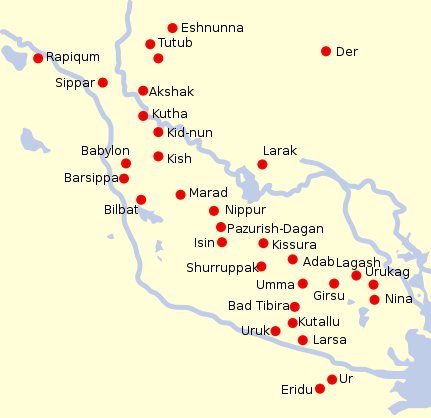
|
| Aug 25 (237) |
26 |
27 |
28 |
29 (*161) |
30 |
| °Aug 21 (233) |
22 |
23 |
24 |
25 (*157) |
26 |
| 'July 29 (*130) |
30 |
31 |
'Aug 1 |
2 (214) |
3 |
| "July 15 |
16 |
17 (*118 = 4 * 29½) |
He Anakena 18 |
19 (200) |
20 |
 |
 |
 |
 |
 |
 |
| Ga4-10 |
Ga4-11 |
Ga4-12 |
Ga4-13 (96) |
Ga4-14 |
Ga4-15 |
|
... They made camp and rested at the Bay of Flies for a week (etahi pohitu). On the eighteenth day of the month of July (Anakena) they went on from Hanga Takaure. They climbed uphill, went on, and reached Poike. When they arrived, they looked around and named (the place) Poike A Hau Maka. They climbed up farther to Pua Katiki. When they arrived there, they looked around and named (the place) Pua Katiki A Hau Maka. They came down from the height, from the mountain, from Pua Katiki, and reached Maunga Teatea. They looked around and gave the name Maunga Teatea A Hau Maka. They all descended, they all came down from Pua Katiki. They reached Mahatua, saw it, looked around, and gave the name Mahatua A Hau Maka. Then they went on and came to Taharoa. They saw it, looked around, and gave the name Taharoa A Hau Maka.
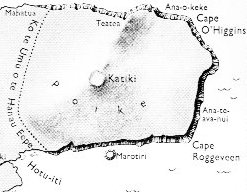
Again they went on and reached Hanga Hoonu. They saw it, looked around, and gave the name Hanga Hoonu A Hau Maka. On the same day, when they had reached the Bay of Turtles, they made camp and rested. They all saw the fish that were there, that were present in large numbers - Ah! Then they all went into the water, moved toward the shore, and threw the fish (with their hands) onto the dry land. There were great numbers (? ka-mea-ro) of fish. There were tutuhi, paparava, and tahe mata pukupuku. Those were the three kinds of fish. After they had thrown the fish on the beach, Ira said, Make a fire and prepare the fish! When he saw that there was no fire, Ira said, One of you go and bring the fire from Hanga Te Pau! One of the young men went to the fire, took the fire and provisions (from the boat), turned around, and went back to Hanga Hoonu. When he arrived there, he sat down. They prepared the fish in the fire on the flat rocks, cooked them, and ate until they were completely satisfied. Then they gave the name The rock, where (the fish) were prepared in the fire with makoi (fruit of Thespesia populnea?) belongs to Ira (Te Papa Tunu Makoi A Ira). They remained in Hanga Hoonu for five days ...
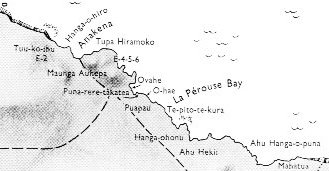
|
In other words, before the introduction of Christianity the year was beginning in July after the old year had ended at the Knot (Ukdah) in JUNE 10 (as recorded from times early on). Counted from the solstice this was day 11 + 161 = 172, i.e. the day number for JUNE 21 according to the new calendar which began with JANUARY 1. Similarly was JUNE 24 (175) evidently a reflection of the old system where the day of St John had been number 11 + 175 = 186. The final at JULY 7 (188) had earlier been day 11 + 188 = 199. The Julian equinox (MARCH 25, 84) had according to the old system been day 95 (= 172 - 77).
... The month, which takes its name from Juppiter the oak-god, begins on June 10th and ends of July 7th. Midway comes St. John's Day, June 24th, the day on which the oak-king was sacrificially burned alive. The Celtic year was divided into two halves with the second half beginning in July, apparently after a seven-day wake, or funeral feast, in the oak-king's honour ...

| CLOSE TO THE SUN: |
| 11-22 |
11-23 |
11-24 |
11-25 (329) |
11-26 (*250) |
11-27 |
| DEC 7 |
8 |
9 |
10 |
11 (345) |
12 (*266) |
 |
 |
 |
 |
 |
 |
| Gb2-6 (32) |
Gb2-7 |
Gb2-8 |
Gb2-9 |
Gb2-10 (82 + 183) |
Gb2-11 (266) |
| BUNDA (Foundation) / KAKKAB NAMMAΧ (Star of Mighty Destiny) |
θ Piscis Austrini (330.1), λ Oct. (330.7) |
| Al Sa'd al Su'ud-22 (Luckiest of the Lucky) / Emptiness-11 (Rat)
TSIN = 36 Capricorni (325.2), ALPHIRK (The Flock) = β Cephei (325.7), SADALSUD = β Aquarii, ξ Gruis (325.9) |
no star listed (326) |
CASTRA = ε Capricorni (327.2), BUNDA = ξ Aquarii (327.5)
SIRIUS (α Canis Majoris)
|
Mahar sha hi-na Shahū-26 (Western One in the Tail of the Goat) NASHIRA = γ Capricorni (328.0), ν Oct. (328.3), AZELFAFAGE = π¹ Cygni, κ Capricorni (328.7) |
Arkat sha hi-na Shahū-27 (Eastern One in the Tail of the Goat) ENIF (The Nose) = ε Pegasi, ERAKIS = μ Cephei (329.2), 46 CAPRICORNI, JIH (the Sun) = κ Pegasi (329.3), ι Piscis Austrini (329.4), λ Capricorni (329.6), ν Cephei (329.7), DENEB ALGIEDI = δ Capricorni (329.8) |

... In China, with Capricornus, Pisces, and a part of Sagittarius, it [Aquarius] constituted the early Serpent, or Turtle, Tien Yuen; and later was known as Hiuen Ying, the Dark Warrior and Hero, or Darkly Flourishing One, the Hiuen Wu, or Hiuen Heaou, of the Han dynasty, which Dupuis gave as Hiven Mao. It was a symbol of the emperor Tchoun Hin, in whose reign was a great deluge; but after the Jesuits came in it became Paou Ping, the Precious Vase. It contained three of the sieu, and headed the list of zodiac signs as the Rat, which in the far East was the ideograph for 'water', and still so remains in the almanacs of Central Asia, Cochin China, and Japan ... |
| Febr 9 (40) |
10 |
11 |
12 (408) |
13 (*329) |
All Hearts' Day |
| °Febr 5 |
6 |
7 |
8 (*324) |
9 (40) |
10 |
| 'Jan 13 (378) |
14 |
15 (*300) |
16 |
17 |
18 (383) |
| "Dec 30 |
Ko Koró 31 |
"Jan 1 |
2 |
3 (368) |
Tua Haro 4 |
| CLOSE TO THE FULL MOON: |
| 5-23 |
5-24 |
5-25 |
5-26 (146) |
5-27 |
5-28 (*68) |
| JUNE 7 |
8 (*79) |
9 |
10 (161 → 172) |
11 |
12 |
| The Knot (Ukdah) |
Rishu A.-13 (Head of the Lion) ψ Leonis (146.4), RAS ELASET AUSTRALIS = ε Leonis (146.6) |
VATHORZ PRIOR = υ Carinae (147.9) |
| Star-25 (Horse) / ANA-HEU-HEU-PO-5 (Pillar where debates were held)
ALPHARD = α Hydrae (142.3), ω Leonis (142.6), τ¹ Hydrae (142.7) |
Al Tarf-7 (The End)
ψ Velorum (143.3), ALTERF = λ Leonis, τ² Hydrae (143.4), ξ Leonis (143.5) |
A Hydrae (144.1)
VEGA (α Lyrae)
|
UKDAH = ι Hydrae (145.4), κ Hydrae (145.5), SUBRA = ο Leonis (145.8) |
| Aug 10 |
11 |
12 |
13 (*145) |
14 |
15 (227) |
| °Aug 6 |
7 |
8 (220) |
9 |
10 |
11 (*143) |
| 'July 14 |
15 |
16 |
17 (*118) |
18 |
19 (200) |
| SIRIUS |
"July 1 |
2 |
3 (*104) |
4 (185) |
He Anakena 5 |
 |
 |
 |
 |
 |
 |
| Ga3-19 |
Ga3-20 (79) |
Ga3-21 |
Ga3-22 |
Ga3-23 |
Ga3-24 |
Inside the head of the 'shark' in Gb2-10 there was an apex sign which could be e-ras-ed:
 |
182 |
 |
| *146 |
*329 |
| met |
emet |
At the time of rongorongo Antares rose with the Sun in day 329 (October 15) as a sign of summer (the season with life) ahead.
Hevelius has a picture of Argo Navis where we can find the significant star of Oannes demonstrating the pulsating nature of life:
"The variations in its light are as remarkable in their irregularity as in their degree. The first recorded observation, said to be by Halley in 1677, although it is not in his Southern Catalogue, made η a 4th-magnitude, but since that [time] it has often varied either way, at longer or shorter intervals, from absolute invisibility by the naked eye [as if it had been swallowed] to a brilliancy almost equal of Sirius. Sir John Herschel saw it thus in December, 1837, as others did in 1843; but gradually declining since then, it touched its lowest magnitude of 7.6 in March. 1886 ..." (Allen)
Its tiny aspect was half hidden in the foliage of the Oak of King Charles, above the old trunk falling down and below the fresh new specimen - as if in the interval between Carina (the Keel) and Vela (the Sail):
… to enter a war canoe from either the stern or the prow was equivalent to a 'change of state or death'. Instead, the warrior had to cross the threshold of the side-strakes as a ritual entry into the body of his ancestor as represented by the canoe. The hull of the canoe was regarded as the backbone of their chief. In laments for dead chiefs, the deceased are often compared to broken canoes awash in the surf ...
.jpg)
... Robur Carolinum, Charles' Oak, the Quercia of Italy and the Karlseiche of Germany, was formally published by Halley in 1679 in commemoration of the Royal Oak of his patron, Charles II, in which the king had lain hidden for twenty-four hours after his defeat by Cromwell in the battle of Worcester, on the 3rd of September 1651 ...
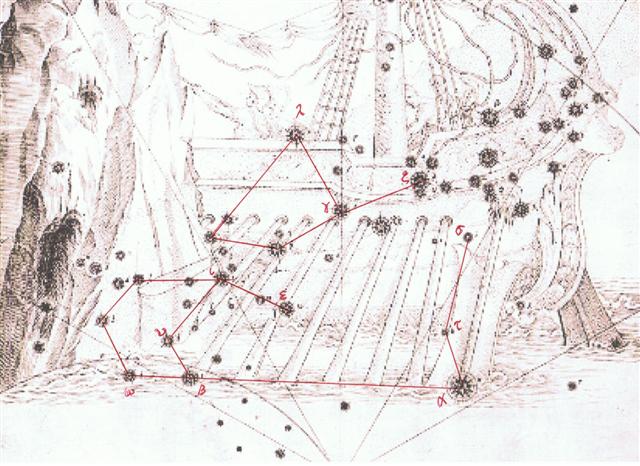
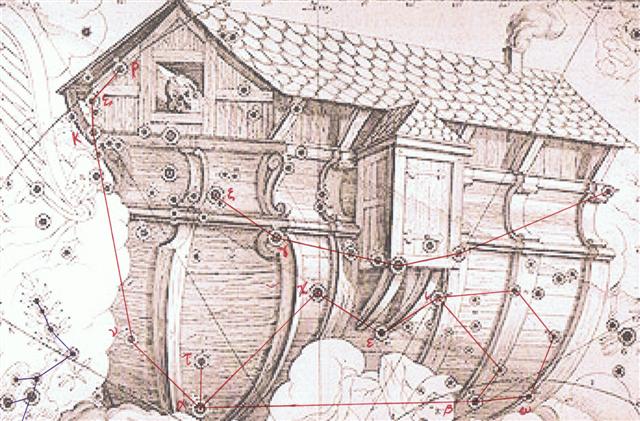
|























.jpg)

